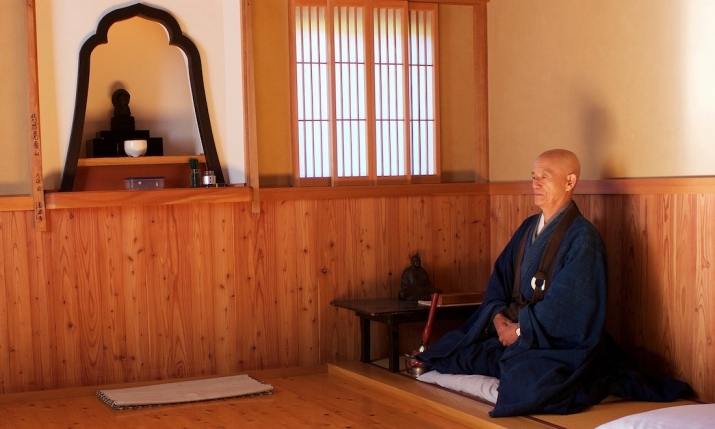NEWS
Almost One-Third of Japan’s Buddhist Temples Expected to Close by 2040
 Bunkei Shibata meditates at the 300-year-old temple Kaigen-ji in Chikuma. Photo by Justin McCurry. From theguardian.com
Bunkei Shibata meditates at the 300-year-old temple Kaigen-ji in Chikuma. Photo by Justin McCurry. From theguardian.comBuddhism may be approaching something of a crisis point in Japan, with 27,000 of the country’s 77,000 Buddhist temples expected to close over the next 25 years, reflecting shrinking populations in small rural communities and a loss of faith in organized religion among the country’s population as a whole.
The Japan Policy Council warned in a report last year that the rapid exodus from rural communities means that almost half of Japan’s municipalities could disappear, along with their places of religious worship, which have traditionally been financially supported by the surrounding community. The report stated that the population of women of childbearing age could drop by half in 50 per cent of municipalities by 2040. And the crisis is not only one of demographics—surveys also indicate that a growing proportion of the public views organized religion as “cheerless” and “inaccessible.”
“The popular image of Buddhist priests as wealthy might still be true in big cities like Tokyo and Osaka, but it’s not the case elsewhere,” noted Hidenori Ukai, deputy head monk of Shogaku-ji, a temple in Kyoto. “At my temple, we have about 120 local patrons, but you need at least 200 to make a living.” Also a journalist and the author of Vanishing Temples: the Loss of Rural Areas and Religion, like many monks in Japan Ukai pursues a second career to supplement his income. (The Guardian)
A recent survey carried out by The Asahi Shimbun newspaper indicated that 12,065 Buddhist temples in Japan were without resident monks, representing 16 per cent of temples affiliated with the 10 most popular schools of Buddhism in the country. The survey also found that 434 temples from 9 major denominations had closed completely in the past decade.
“Japanese Buddhism has gone on a strange direction,” said Bunkei Shibata, the 80-year-old head monk of Kaigen-ji, a 300-year-old Zen Buddhist temple in the city of Chikuma in Negano Prefecture. “These days most people associate it with funerals, but there is much more to it than that.” (The Guardian)
Shibata, who trained with the Rinzai-Myoshinji school after retiring in 2006, asserted that for Japanese Buddhism to survive another 1,500 years, 50 per cent of priests should be appointed from outside the traditional family succession route. Shibata aims to leverage Japan’s aging demographics by reaching out to the growing number of retirees. Of the 47 people who have completed Shibata’s training course for retirees, 23 have gone on to train as priests, 7 of whom are running their own temples.
“Years ago people reckoned they had about 10 years left after retirement, so they would just try to enjoy themselves. But people are living much longer now and they want to do something more meaningful with their time after they retire,” he said. “Older people have a wealth of life experiences and that makes them ideal material for the priesthood. And, let’s be honest, the older you get, the more you think about your own mortality, and the more open you are to religious ideas.” (The Guardian)
Emphasizing that modern monastics should act as mentors and counselors and do more to spread Buddhist teachings to the public, Shibata underlined the vital role that Buddhism played in helping people cope in the aftermath of Japan’s March 2011 earthquake. Temples opened their doors to survivors and monks reached out to offer spiritual advice and comfort. “That’s exactly what they should be doing. When people are going through difficult times in their lives, it is our responsibility to help them,” he said. (The Guardian)
See more
Zen no more: Japan shuns its Buddhist traditions as temples close (The Guardian)
Report: Nearly 50% of municipalities to lose half of their young women by 2040 (The Asahi Shimbun)
Survey Reveals Over 12,000 Temples in Japan Lack Resident Monks (Buddhistdoor Global)














